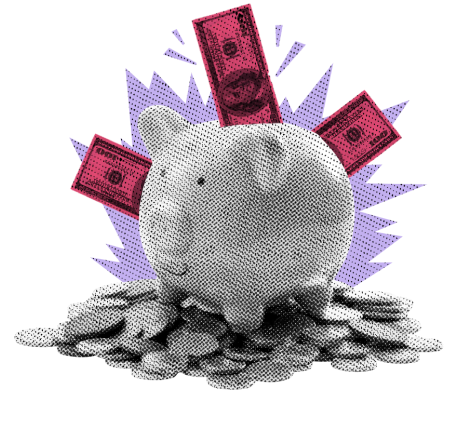
Summer check-in on markets, politics, tariffs, and whether 2025 is shaping up to be a "V" or just a tease.
KEY TAKEAWAYS
- The first half of 2025 was marked by extreme volatility, driven by policy surprises and global trade tensions.
- The MAG-7 stocks saw major swings, underperforming the broader market after tariff announcements.
- Consumer and corporate sentiment dipped and rebounded sharply, forming “V”-shaped patterns.
- Despite a GDP contraction, earnings stayed positive, and AI-driven tech remained resilient.
- Trade negotiations, monetary policy, and fiscal developments will define the next six months.
MY HOT TAKES
- The market got ahead of itself pricing in a pro-business President and ignored the inevitable tariff shock.
- Tesla’s valuation was more about political proximity than product performance.
- Retail investors always seem to be one headline behind—and it’s costing them.
- Sentiment is whiplashing, but behavior isn’t aligning—people say they’re scared but keep spending.
- A V-shaped recovery feels good—but might just be a pause between body blows.
- You can quote me: “With the economy, on Wall Street, we like it sizzling hot while our sometimes-friend Fed prefers it lukewarm.”
Is V for victory? Well, my friends, we have almost made it to the halfway mark, and it was most certainly not a direct shot. The year started with high optimism on the back of a year that was mostly filled with high optimism. What was expected to be a messy election turned out to be anything but. Sure, half of the US may have been disappointed, but the elections were smooth, and the mandate was well understood.
I need to start with my standard disclosure. You know the rules, policy not politics. So, politics aside, the mandate I am referring to is the US Economy. On Wall Street, we like it sizzling hot while our sometimes-friend Fed likes it lukewarm. The President is on our side preferring growth growth growth, and this did not escape investors of all types from charging into the markets, bidding up anything that would be in the new President's sites; crypto, banking, tech, fossil fuel-related companies, etc.
Some of the opportunities seemed pretty certain, while others were complicated. A perfect example of a complicated investment thesis is Tesla. Tesla, the once global leader in electric vehicles, got to its top spot with a lot of help from government subsidies seeking to promote clean energy transportation. Candidate Trump’s platform was clearly against the getting-long-in-the-tooth green movement, so it was clear that any company that benefited from that so-called “green wave” would come up short in a Trump win. One of those companies was Tesla and its founder and Chief Elon Musk played a critical role in the President's win and his administration. Tesla’s stock would benefit from Musk’s association but not so much from its income statement. The result would have the already-volatile stock go from leader to loser in a short time period. Ultimately, it would be Musk’s “retirement” from DOGE that would rescue the faltering stock–not its income statement. The reason I bring this up is to demonstrate the complex mechanism under which stocks have been trading since… since well, the elections in November 2024, and more specifically, since the President was inaugurated in January.
Just as the last retail investor got the news of the newly crowned pro-business President and decided to buy the Mag-7, the news hit the market like a ton of bricks. It was mere days if not hours that the President moved into the White House that he began to make good on all of his campaign promises, including the ones on tariffs. For some reason, as Wall Street tends to do sometimes, the bad news was buried in the good news. In other words, it should not have been a shock, though for some reason it was. Not only was the market taken by surprise by the tariffs, but it was knocked onto its… um, what’s the polite word for 🫏. While some may have factored in tariffs, no one expected them to be so large and far-reaching. They would only get larger and reach farther in the weeks that followed. Stocks tumbled causing severe hemorrhaging in America’s retirement portfolios. The expected Trump Put was nowhere to be found.
Just as the last retail investor–maybe even the same guy from the last paragraph ☝️–got the news that the President was serious about these tariffs and sold the Mag-7, the President expressed interest in negotiating with… well, everyone on the tariff list which was… well, literally everyone in the world. This would be the beginnings of a rally that brought the Nasdaq from bear market to bull market territory in what seemed like days. It would bring the S&P 500, which came within inches of a bear market, back to almost break even for the year.
Throughout all this, US GDP went from expansion to contraction, and corporate America had two consecutive positive earnings seasons. The market-leading Mag-7 showed us that AI is far from out of gas. And all those bad economic numbers that were expected any day… didn’t show up… at least not yet.
Consumers were on edge as confidence tanked. Tariffs and their results struck fear in consumers which began to expect a reemergence of inflation and economic decline–stagflation. Though most Americans could probably not spell the word correctly or even know what it meant without asking ChatGPT, they still feared it enough to tell the nice pollsters at The Conference Board or University Michigan that they were fearful. Would that fear result in a decrease in consumption? Well, no, not yet at least. In fact, consumer confidence came roaring back in both the Conference Board’s latest reading and Michigan’s latest monthly revision. Can you see a similar V-pattern as described above?
In the corporate world, line managers responsible for making stuff happen were a bit on edge as well. I like to call Purchasing Managers Indexes, or PMIs, the corporate cousins of consumer confidence, because they represent corporate sentiment and they are also based on polling information. PMIs are given a bit more weight on Wall Street because corporate managers may not be quite as “emotional” and politically motivated as individuals. I think that they are both important, though neither should be viewed in a vacuum. They are simply one factor in a very large factor model that moves markets. That said, manufacturing PMIs followed a similar path to their consumer cousins, falling on fears of tariff-borne disruption. It made sense, tariffs add cost and cause supply chain disruptions, so as one would expect, regardless of political party, corporate managers would likely be sour on them. And they were… for a minute. They have recently turned more positive as the administration began to delay tariffs and seek resolution. Another V-pattern.
So it has been quite the round trip for the markets and stocks this year so far. Check out this chart then follow me to the finish.

This chart shows year to date total return of the S&P 500 Index (white line), the Nasdaq Composite Index (red dashed line), and the Mag-7 Index (yellow dotted line). You don’t have to stand too far back to see the V-pattern which I have been talking about. Not surprisingly, the Mag-7 had the biggest swing falling by almost -26% at its worst and still below water by around 4%. The S&P is just above water and the Nasdaq–we’ll call it break even.
Looking at this chart and after hopefully following my commentary 🤓, you would assume that positive momentum is in favor of future gains. But is it? What will the second half of 2025 look like? Well, on Friday, you may have missed the news that the administration said that China had broken its promises in the ongoing trade negotiations. Markets still managed to stay stable despite a mixed close as progress with other negotiations was touted as being positive. Not sure if it was net net good or bad? Don’t worry, you're not alone. This morning, WHILE YOU SLEPT, China accused the US of breaking its promises in trade negotiations. No one is calling this a trade war yet, but that type of back-and-forth rhetoric is, unfortunately, a hallmark of one.
The remainder of the year is sure to see a continuation of volatility driven by the news cycle. It is only during rare periods of squelched news that true economic numbers and corporate earnings will be able to shine through. Unfortunately, it is unclear whether those numbers will be positive or negative for the markets. We cannot, however, ignore that there may be positive news on the fiscal policy front with a ratification of a tax reconciliation bill. On the monetary front, the Fed is poised to lower rates further by year end. The economy, markets, and it seems, even the Fed itself is mixed on how much and when those might occur. Indeed, any or all of those could help ultimately determine if by year end, we end up with a V, a W, or a worst-case upside-down W. The best advice I can give you at this point is to wear a pair of practical and comfortable shoes. The last China-trade deal took 631 days to resolve. In other words, our journey is far from over. Let’s lace up and carry on.
FRIDAY’S MARKETS
Stocks had a mixed close on Friday as inflation continued to cool down and consumer sentiment showed a bit more optimism. Trade tit-for-tat was not in short supply as traders tried to make heads or tails of the mixed messaging.

NEXT UP
- S&P Global US Manufacturing PMI (May) is expected to come in at 52.3 in line with earlier, flash estimates.
- ISM Manufacturing (May) may have gained to 49.5 from 48.7.
- Construction Spending (May) is expected to have climbed by 0.2% after declining by -0.5% in the prior period.
- Fed speakers today: Logan and Goolsbee. Chairman Powell will speak at 1:00 PM Wall Street Time.
- Later this week: still some important earnings along with Factory Orders, JOLTS Job Openings, ADP Employment Change, ISM Services Index, Fed Beige Book, and monthly employment numbers. All potential market movers, so download attached calendars so you can be ready.
DOWNLOAD MY DAILY CHARTBOOK HERE 📈
.png)

